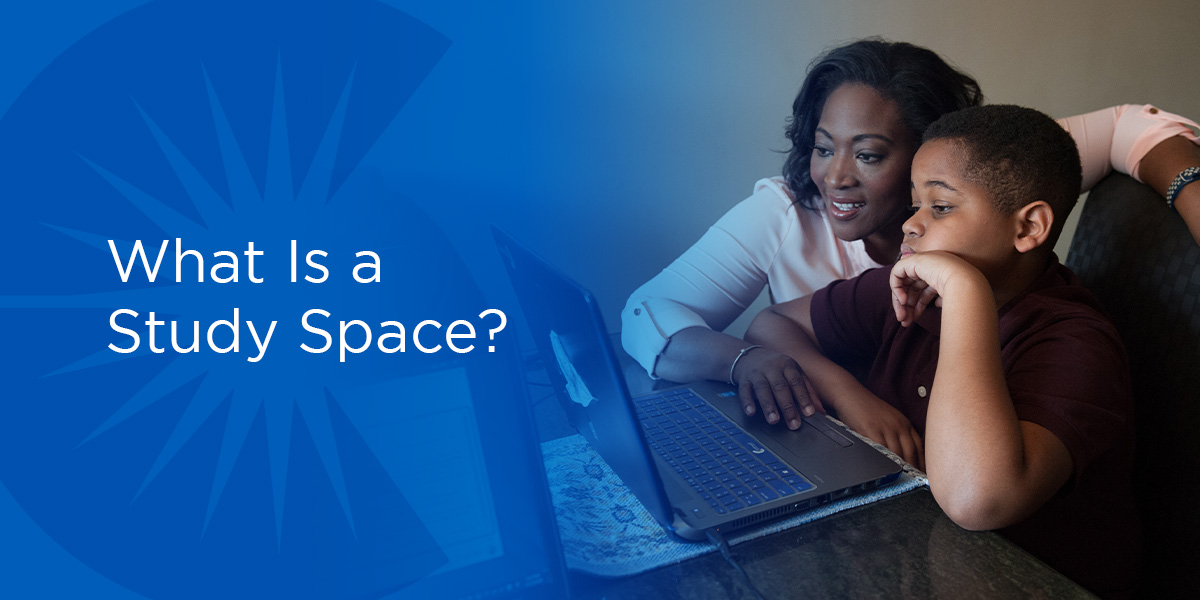2025-2026 School Year Enrollment Now Open. Click Here
2025-2026 School Year Enrollment Now Open. Click Here

A study space is an area you dedicate to researching, completing assignments, and learning. These spaces separate schoolwork from fun time and help students stay productive and focused. There are no rules to creating a study space. You can create the perfect virtual school setup from your kitchen, bedroom, home office, or any other area in your home. You can also use a desk, table, and other furniture to give your student the flat surface they need to work.
Although your child’s study space can be anything you want, a few key distinctions make a productive study space. Here, we’ve crafted some virtual learning space ideas that can help your child get in the school work groove and stay focused as they complete research papers, prepare projects, and review for exams.
When creating a virtual learning space at home, consistency is key. Your child needs a space that indicates when to turn off their devices and focus their efforts on coursework and assignments. You should try to keep work and play spaces separate whenever possible. Teach your child that their workspace is for focus and productivity, so they know they need to accomplish their tasks when they sit down. Over time it will become easier for them to enter the space and quickly get down to business as they associate that space with work.
Separating spaces also encourages a better school-life balance as they plan their school day around activities, friends, and family events. When work and play intersect, it can be difficult to determine when to unwind for the evening or pick up the pencil again, leading to poor time management and stress.
When building a distance learning home setup, it’s essential to cater to your child’s needs. A learning space for kids in elementary will look different than a workspace for high schoolers. Every child is different, so you should create a space that reflects your child’s learning method, needs, and age.
Elementary students will likely need coloring supplies, such as markers, pens, crayons, and colored pencils. They may also need a ruler, glue sticks, tape scissors, or dry erase markers. Young students may benefit from having a family space to work in, such as the kitchen, so they can ask questions if they get stuck.
Middle schoolers might use index cards, highlighters, pens, pencils, and notebooks. At this age, some students may start considering the aesthetic of their workspace and feel more comfortable with a larger desk in their private space. They may begin to work more independently and want to add decorations like bulletin boards or calendars that make the space personal while increasing productivity.
By high school, students are more focused on desk work. They will likely need a planner, notebooks, pens, and pencils and have an idea of additional supplies that work for their learning method. For instance, some prefer to use index cards for studying, while other students may benefit from an additional computer program where they can store class notes.
Whether your child works at the kitchen counter or in a home office, keeping an eye on their computer usage will help you ensure they stay on task and complete their work. You should discuss safety procedures for physical and online computer use.
Steps you should take to ensure your child is using their computer correctly and safely include:
Organization plays a vital role in staying productive, reducing stress, and promoting overall wellness. Work with your child to clean their space and find a proper place for every item, while still encouraging independent organization. Remember that organization looks different for everyone and understanding your child’s strategy will encourage you to work together.
Having thoughtful discussions with your child about what organization means and how to follow the best practices can help them keep their school supplies and assignments neat and tidy. You should often check on your child’s space and ensure it isn’t cluttered as the school year goes by. Set a schedule to remove excess papers they don’t need so the area doesn’t become crowded.
For older students, keeping to-do lists, using planners and binders, and incorporating a timer can help keep them on track to finish their assignments before due dates, locate information quickly, and promote a healthy work-life balance.
To stay as organized as possible, your child will likely need a lot of storage space for all their necessary supplies. Items on their desk can quickly become a distraction or get lost in a sea of papers and folders. Putting all extra pencils, crayons, notebooks, and supplies into desk drawers or shelves will help keep the workspace clear of clutter.
Younger learners need space for hands-on learning activities and the room to measure, paint, draw, or glue different projects. If they’ve already filled the desk drawers and shelves, you can still get handy in other ways. Install shelves on the wall to provide extra storage space, or get a cube storage unit with many different compartments for their supplies.
Commonwealth Charter Academy provides students with a dynamic learning environment from the comfort of their own homes. We’re a fully online public charter school in Pennsylvania, and we’ve been breaking the mold since we started in 2003.
We run the way traditional schools should by giving each student the individual attention they need to succeed. At CCA, your child will get to explore their interests and take courses that help them reach their goals. We know every child is different and moves at their own pace, so we customize education plans to fit their needs.
For more information about virtual learning or our unique and dynamic learning program, reach out to us. We’d love to hear from you and can’t wait to meet your young learner.
2025-2026 School Year Enrollment Now Open. Click Here